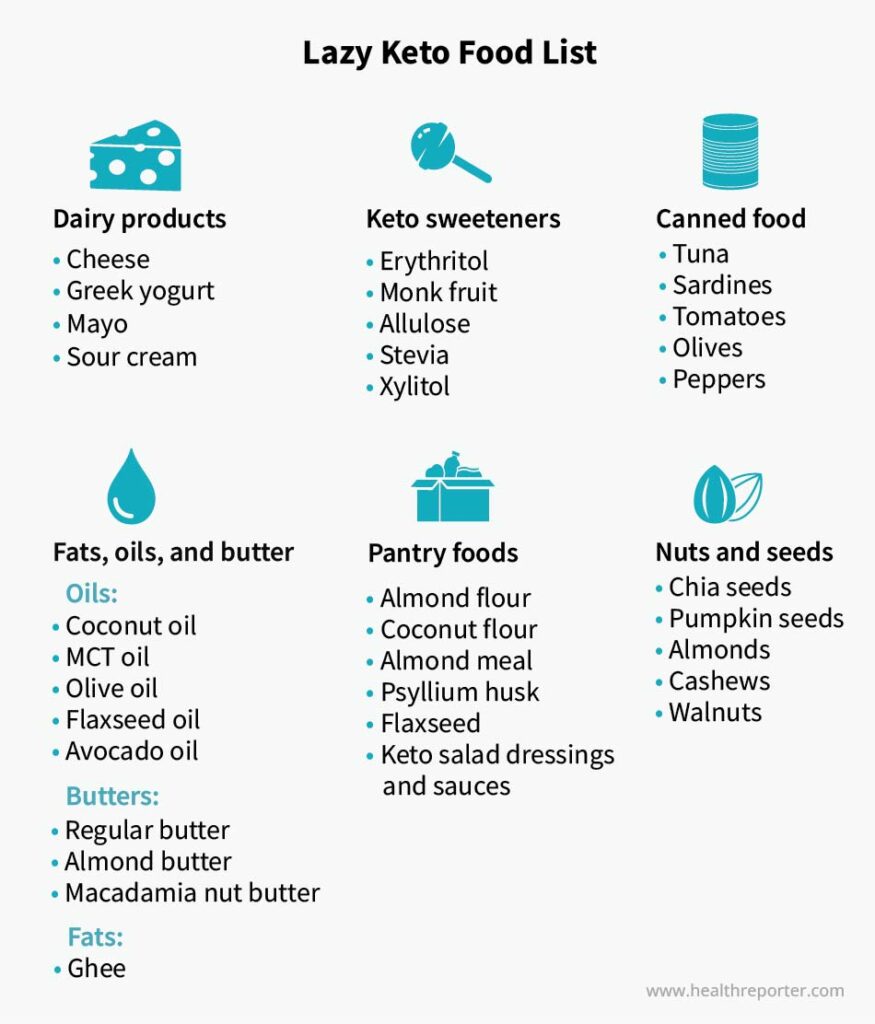Lazy Keto 101: An In-Depth Guide
Lazy keto offers an alternative approach to the traditional keto diet. It appears to be the more manageable and less restrictive option, but does the lazy keto diet deliver the same results? Keep reading to learn about lazy keto, including its health benefits and risks.

The classic ketogenic diet is a proven weight loss diet with a ton of devoted followers.
The concept focuses on eating a high-fat, moderate-protein, low-carb diet. The goal is to force the body into an alternative metabolic state called ketosis, where the body burns fat for fuel. Unlike other popular low-carb diets, fat is the superior nutrient that rules the ketogenic diet.
At a glance, it sounds reasonably straightforward – you cut back on carbs and eat a lot of healthy fats. In reality, however, success with a strict keto diet typically requires a certain level of organization and planning to manage and keep track of your macronutrient intake.
This article covers everything about lazy keto – the lazier version of keto dieting.
What Is a Lazy Keto Diet?
The lazy keto diet is a simpler version of the keto diet that only considers carbohydrate intake. While a traditional keto diet centers around the macros ratio of 70% fat, 20% protein, and 10% carbs, a lazy keto diet restricts carbs without tracking protein and fat. Carb intake typically remains at 10% or less of total daily calories.
As a lazy keto dieter only has to worry about counting net carbs, the diet is considered less restrictive. It remains a very low-carb diet that some people may find challenging to follow, but the participant doesn’t have to monitor macros or calorie intake carefully.
So, when going to the grocery store, your lazy keto food list will only consist of low-carb foods to enjoy and high-carb foods to avoid. You can eat foods containing fat and protein as you like. The concept of lazy keto is to promote weight loss by significantly cutting daily carbohydrates.
Is Lazy Keto Healthy?
Depending on how you approach lazy keto, it can be a healthy or unhealthy diet. If you go down the completely lazy route, your diet might restrict net carbs to under 50g per day, but you’re likely going to consume processed foods and pay little attention to overall food quality.
So, while you might adhere to the rules surrounding daily net carb intake, your body will not be receiving the nutrition it needs. This approach to keto is known as dirty keto. A dirty keto diet allows for highly processed and junk foods that offer little benefit to your overall health.
If you follow a clean keto diet – the one that focuses on high-quality whole foods and unprocessed foods – you can ensure your body is getting plenty of essential nutrients to keep strong and healthy. This will help you lose weight while optimizing your overall health.
To make the lazy keto diet as healthy as possible, you should create lazy keto meals that consist of powerful natural foods. While fat and protein are not your primary concern, you should still aim to eat healthy fats, lean proteins, and lots of nutrient-dense, low-carb veggies.
How to Follow a Lazy Keto Diet?
It’s pretty straightforward to follow a lazy keto diet because all you need to pay attention to is carbs! First things first, you need to determine how many carbs you can consume as part of your daily allowance. You can discover your ideal amount by entering your details into a keto macros calculator. Once you have your personalized calculation, you can start meal planning.
The average number of carbs for most keto dieters is 20–50 grams of net carbohydrates per day. The total equates to the 5–10% calculation of total daily calories based on a 2,000-calorie per day diet.
Counting net carbs is your major concern on lazy keto, so you must rigorously track how many you eat daily. You can keep count by always checking food labels and calculating net carbs from total carbs. Stick to your budget at all times for greater success with lazy keto.
When grocery shopping for carbohydrate food sources, try to opt for complex carbs over simple carbs. Complex carbs are found mainly in plant foods and contain plenty of dietary fiber to optimize your digestive and overall health.
What’s the Difference Between Lazy Keto and Keto?
The most distinctive difference between lazy keto and keto is the number of rules and restrictions. Keto diets are fairly strict. Carbohydrate intake is kept to the bare minimum, protein intake is moderate, and fats overpower the diet, making up a vast proportion of your daily calories. There is just as much emphasis on fat intake as there is on net carb intake.
Lazy keto, on the other hand, only pays attention to carbs. The lazy philosophy is not concerned with calculating other macronutrients. It also doesn’t count calories. It is aptly titled because it is ultimately the lazier approach to the strict keto diet.
People practice keto to enter the fat-burning metabolic state known as ketosis. Achieving ketosis requires a perfect macros ratio of very few carbs, a medium amount of protein, and a lot of fat. Your body burns the fat for fuel as it no longer has access to a steady supply of carbs.
As the lazy keto requirements are less than perfect, there is no guarantee that you will get into ketosis on this diet. It’s worth noting that even too much protein can trigger your body to produce glucose in a process called gluconeogenesis, preventing you from reaching ketosis.
3 Benefits of the Lazy Keto Diet
So, what are the perks of lazy keto, and why might somebody choose lazy keto over the original keto diet?
There are a handful of reasons to try the lazy keto diet. When done right, it can help you cut back on highly refined foods and sugary snacks to help you lose weight and improve your general health. Furthermore, it can help some people ease into a stricter ketogenic diet.
Below you can discover the top 3 lazy keto benefits.
#1 Suppresses appetite
Low-carb diets tend to reduce appetite.
For the most part, appetite reduction comes down to replacing your carbohydrate intake with a higher fat and protein intake. Although the lazy keto diet doesn’t necessarily prioritize fats and proteins, you naturally increase these two essential macronutrients when you cut carbs.
Foods rich in protein and fats promote satiety, reduce food cravings, and help regulate appetite. The fact that a low-carb diet can eliminate or at least minimize hunger pangs is what makes the ketogenic diet so popular among people who are focused on losing weight.
Additionally, a low-carb meal plan can promote blood sugar control, which helps regulate appetite and provides more steady energy levels.
#2 Helps to lose weight
Low-carb diets, particularly keto diets, are associated with rapid weight loss.
Ordinarily, carbohydrates are your primary fuel source as they provide your body with glucose for energy. When you cut carbs from your diet, your body’s glucose stores deplete, and your body must search for alternative fuel. It begins burning body fat, which speeds up weight loss.
Furthermore, many high-carb foods are high in calories. Cutting down on such foods naturally reduces your daily calorie intake. Reducing calories helps you reach a calorie deficit, taking in fewer calories than you burn. A calorie deficit is the key to weight loss.
#3 More sustainable than a strict keto diet
Some people may find it easier to sustain a lazy keto diet over the keto diet because of fewer restrictions. Essentially, as long as you eat very few carbs, you’re adhering to the lazy keto rules and succeeding in your goals. There is little else to worry about in your daily diet.
Lazy keto may be more appealing to those who do not want the perceived hassle of counting calories and monitoring protein and fat intake. Concentrating solely on carbohydrate intake is less time-consuming than keeping a check on all macronutrients. It allows more freedom.
Moreover, you don’t need to concern yourself with calorie restriction – an element many dieters struggle to sustain.
Possible Side Effects of the Lazy Keto Diet
Ketogenic diets have side effects, even the lazy keto diets. The most likely issue to occur when you first start with lazy keto is developing keto flu – a non-medical term for a bunch of symptoms that appear during the initial stages of your transition to eating low-carb.
Symptoms include nausea, vomiting, headache, fatigue, and keto breath. Digestive issues are also common, including constipation and keto diarrhea. These symptoms tend to subside as your body adapts to a new way of functioning.
Nutritional deficiencies are another significant concern for people following the lazy keto or any keto diet. Restrictive diets that limit or eliminate certain food groups can lead you to miss out on important macro and micronutrients that keep your body in prime condition.
While weight loss is the goal, it’s possible that the lazy keto diet may cause weight gain. If you don’t know exactly how much protein or fat you are consuming, you could end up overeating calories. Too much protein can make you gain weight as excess protein stores as fat in the body.
Foods to Eat on a Lazy Keto Diet
The vital component of the lazy keto diet is to limit carbohydrate-rich foods. A typical lazy keto diet allows 10% of total calories to come from carbohydrates. For your small allowance, it is essential to eat whole foods and nutrient-dense carbs that make up a balanced diet.

Low-carb foods to include in your lazy keto recipes are:
- Meat, including beef, lamb, and pork (bacon, corned beef, ham, pepperoni, and others)
- Poultry, including chicken and turkey
- Fish and seafood
- Eggs
- Non-starchy vegetables, such as asparagus, broccoli, cabbage, cucumber, and leafy greens
- Nuts and seeds
- Dairy products, like full-fat Greek yogurt, milk, and cream cheese
- Healthy oils, like avocado and olive oil
- Small amounts of low-carb fruits, such as raspberries and strawberries
- Various store-bought dressings, such as blue cheese dressing or Caesar dressing
- Coffee creamers, such as Coffee Mate
- Diet soda, MiO water enhancer, and similar drinks with artificial sweeteners
Foods to Avoid on a Lazy Keto Diet
The diet itself doesn’t determine which carbs you shouldn’t eat, but if you want to avoid following a dirty keto diet full of unhealthy foods, it’s better to avoid the below foods:
- Refined grains, including white bread, white pasta, and white rice
- Starchy vegetables, such as potatoes, sweet potatoes, and corn
- Most legumes, including beans, chickpeas, and lentils
- Processed meats and vegetable oils
- Sugary foods, like cakes, pastries, sweets, and other sugary snacks
- Sugary sodas
- Fruit juice
A Word From Our Nutritionist
Lazy keto is a modification of the ketogenic diet.
It differs quite significantly from the standard ketogenic diet. This is primarily because lazy keto has only one rule, which is keeping track of your daily intake of carbohydrates. In contrast, keto emphasizes the number of fats and protein you must include in your diet.
As a lot of people struggle to get the macros requirements right on keto. The lazy addition is appealing because it is relatively simple. You don’t need to concern yourself with eating lots of good fats on keto or moderating your daily intake of protein-based sources.
Of course, this alters the original goal of the ketogenic diet – to reach the metabolic state of ketosis. Without full control over your macros, you cannot guarantee that you will push your body into fat-burning mode. Plus, you might feel hungry without enough fats and protein.
However, you can still expect to shed some pounds by slashing your regular carb consumption.
Given that this form of dieting is still restrictive, it is essential to talk to your doctor or dietitian before partaking in lazy keto. Eliminating many healthy foods from your diet can cause nutritional deficiencies in the long term. You must only follow a diet that is safe for you.
Conclusion
The lazy keto diet is a modification of the traditional keto diet that offers dieters an easier meal plan to follow. It provides a more accessible option to those who do not want to religiously monitor their entire macronutrient intake and instead focus solely on carbs.
Lazy keto encourages people to reduce their overall carb and sugar intake, which can encourage weight loss. However, without monitoring fats and protein, you may not reach ketosis, and, therefore, you won’t lose weight as speedily as you would with the original keto diet.

















































 Select your language:
Select your language: 








